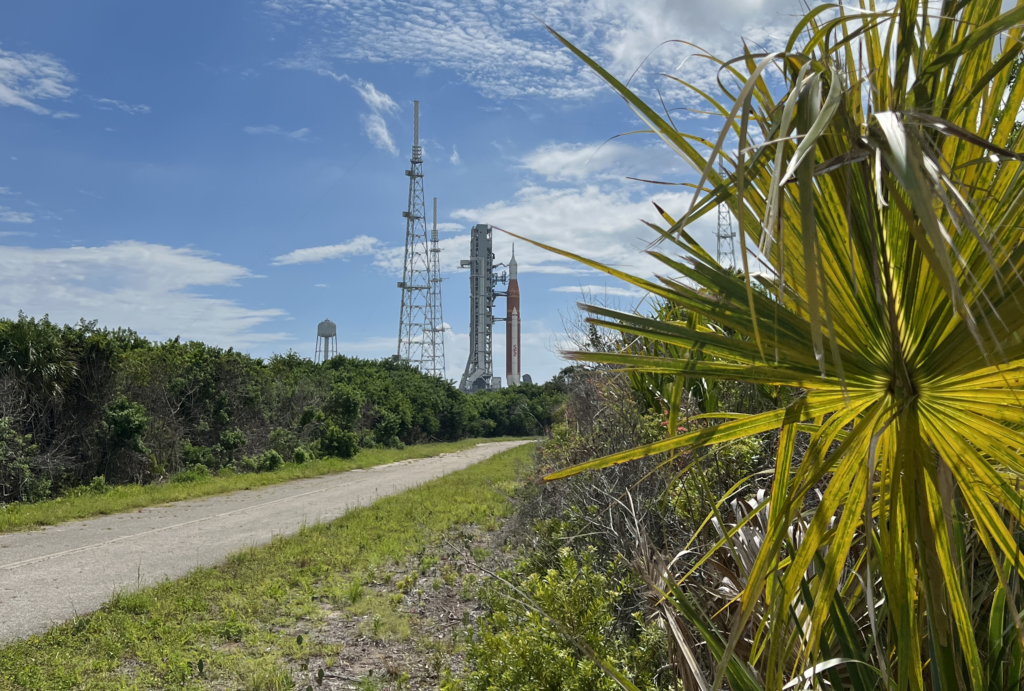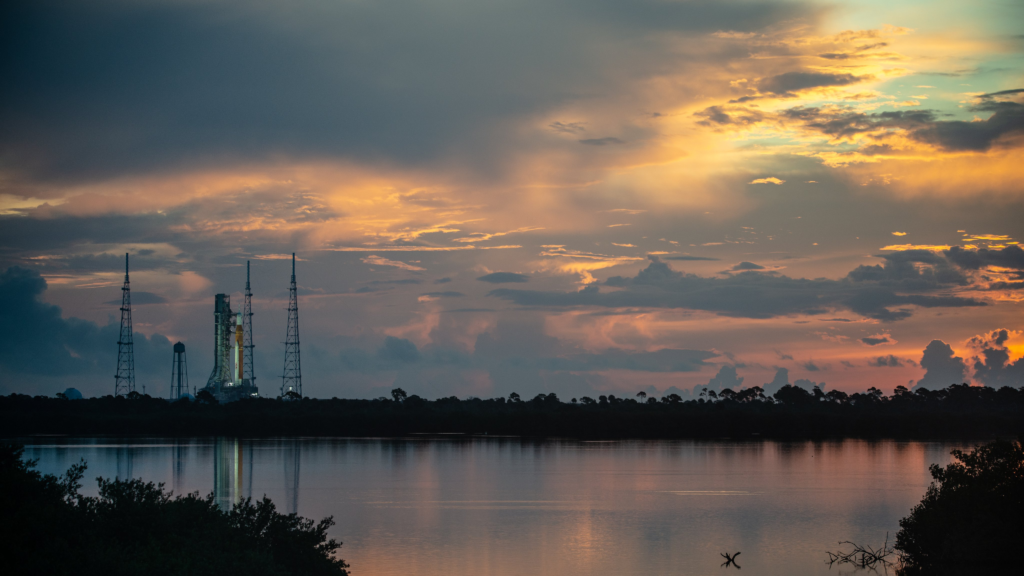
The Last Update Before The First Launch Of SLS
It has been around half a century since humans first stepped foot on the Moon. In the time since this achievement, a lot has been accomplished with the exception of a sustained presence on the celestial body. Thankfully, now in 2022, we are only days away from a massive step towards not only returning humans to the surface, but setting up a more permanent human presence.
For years now NASA has been working on Artemis. While this program encompasses a massive list of different projects trying to get us back on the Moon, the Space Launch System is arguably the backbone of it. SLS is expected to transport both crew and cargo to and from the Moon playing an extremely important role. Right now NASA is targeting August 29th for the first launch of this rocket apart of Artemis I.
While this mission isn’t carrying any crew, it will demonstrate the rocket’s capabilities and prepare for Artemis II which will bring a crew further than ever before. The success of Monday’s mission will have a major impact on the future of Artemis. Here I will go more in-depth into the upcoming launch, chances of delay, what to expect, and more.
Launching In Two Days

As of right now on the 27th, the first launch of SLS is still set to happen only two days from now on Monday the 29th. Earlier this month we watched the Space Launch System rocket and Orion spacecraft arrive atop Launch Complex 39B at NASA’s Kennedy Space Center in Florida after a nearly 10-hour journey from the Vehicle Assembly Building. Once it had arrived, managers from across NASA gathered at the agency’s Kennedy Space Center in Florida to start the Artemis I mission Flight Readiness Review (FRR). Over several hours, the FRR focused on the preparedness of the Space Launch System rocket, Orion spacecraft, ground systems at Kennedy, flight operations at NASA’s Johnson Space Center in Houston, and space communications and navigations networks to support the flight, and the certification of flight readiness. Later that same day on the 22nd, the Flight Readiness Review for NASA’s Artemis I mission was concluded, and teams proceeded toward a two-hour launch window that opens at 8:33 a.m. EDT Monday, August 29, from Kennedy Space Center’s Launch Pad 39B in Florida.
This brings us to today as we get very close to the expected launch. Only two days ago NASA released an initial report regarding weather and the chances of moving the launch date. Specifically, Meteorologists with the U.S. Space Force Space Launch Delta 45 currently predicted a 70% chance of favorable weather conditions for launch on Aug. 29. The primary weather concern for the two-hour launch window is scattered rain showers. In addition to the weather report, the agency highlighted that At Launch Pad 39B, technicians completed servicing the hydraulic power units on the Space Launch System rocket’s boosters Wednesday. After finishing final work inside the Orion crew module, including loading the Snoopy zero gravity indicator and removing soft covers protecting Orion’s windows and seats, the crew module hatch was closed at approximately 3:30 a.m. Thursday. Next, engineers will close the launch abort system hatch and retract the crew access arm used to provide access to the spacecraft. Booster and core stage engine service platforms as well as side flame deflectors have been moved into position for launch.
Moving on to yesterday, Meteorologists with the U.S. Space Force Space Launch Delta 45 continued to predict a 70% chance of favorable weather conditions for launch of Artemis I on Aug. 29th. The primary weather concern for the two-hour launch window was still scattered rain showers. The weather guidelines for NASA’s Artemis I flight test identify conditions to launch the agency’s Space Launch System and Orion spacecraft. Also, at Launch Pad 39B, engineers closed the launch abort system hatch and retracted the crew access arm. Teams continue to plan to begin the countdown for launch at 10:23 a.m. EDT Aug. 27th. Finally, only a few hours ago, NASA tweeted saying, “The mission management team for Artemis I met this morning to review the status of operations and polled “go” to proceed with the launch countdown.” All of this news combined with the consistent weather report means a launch in only two days is very likely. This being said, Florida is known for some serious spontaneous weather and we will have to wait and see what happens this Monday. As of right now, NASA is targeting launch on Aug. 29th during a two-hour launch window that opens at 8:33 a.m. EDT, with backup opportunities on Sept. 2nd and 5th. A successful launch on Aug. 29th would result in a mission duration of approximately 42 days, with a targeted Orion splashdown on Oct. 10th.
Artemis I

Now that we know the current progress of the mission and the chances of it happening, we can take a closer look at what to expect if the launch does occur. Artemis I will be the first integrated test of NASA’s deep space exploration systems: the Orion spacecraft, Space Launch System rocket, and the ground systems at Kennedy Space Center in Cape Canaveral, Florida. The first in a series of increasingly complex missions, Artemis I will be an uncrewed flight test that will provide a foundation for human deep space exploration, and demonstrate our commitment and capability to extend human existence to the Moon and beyond.
The mission begins by leaving Earth. SLS and Orion will blast off from Launch Complex 39B at NASA’s modernized spaceport at Kennedy Space Center in Florida. The SLS rocket is designed for missions beyond low-Earth orbit carrying crew or cargo to the Moon and beyond, and will produce 8.8 million pounds of thrust during liftoff and ascent to loft a vehicle weighing nearly six million pounds to orbit. Propelled by a pair of five segment boosters and four RS-25 engines, the rocket will reach the period of greatest atmospheric force within ninety seconds. After jettisoning the boosters, service module panels, and launch abort system, the core stage engines will shut down and the core stage will separate from the spacecraft. From here it will deploy its solar panels and eventually, the ICPS will deploy a host of CubeSats.
As Orion continues on its path from Earth orbit to the Moon, it will be propelled by a service module provided by the European Space Agency, which will supply the spacecraft’s main propulsion system and power (as well as house air and water for astronauts on future missions). Orion will pass through the Van Allen radiation belts, fly past the Global Positioning System (GPS) satellite constellation and above communication satellites in Earth orbit. To talk with mission control in Houston, Orion will switch from NASA’s Tracking and Data Relay Satellites system and communicate through the Deep Space Network. From here, Orion will continue to demonstrate its unique design to navigate, communicate, and operate in a deep space environment. The outbound trip to the Moon will take several days, during which time engineers will evaluate the spacecraft’s systems and, as needed, correct its trajectory. Orion will fly about 62 miles (100 km) above the surface of the Moon, and then use the Moon’s gravitational force to propel Orion into a new deep retrograde, or opposite, orbit about 40,000 miles (70,000 km) from the Moon.
For its return trip to Earth, Orion will do another close flyby that takes the spacecraft within about 60 miles of the Moon’s surface, the spacecraft will use another precisely timed engine firing of the European-provided service module in conjunction with the Moon’s gravity to accelerate back toward Earth. This maneuver will set the spacecraft on its trajectory back toward Earth to enter our planet’s atmosphere traveling at 25,000 mph (11 kilometers per second), producing temperatures of approximately 5,000 degrees Fahrenheit (2,760 degrees Celsius) – faster and hotter than Orion experienced during its 2014 flight test. After about four to six weeks and a total distance traveled exceeding 1.3 million miles, the mission will end with a test of Orion’s capability to return safely to the Earth as the spacecraft makes a precision landing within eyesight of the recovery ship off the coast of Baja, California. Following splashdown, Orion will remain powered for a period of time as divers from the U.S. Navy and operations teams from NASA’s Exploration Ground Systems approach in small boats from the waiting recovery ship. The divers will briefly inspect the spacecraft for hazards and hook up tending and tow lines, and then engineers will tow the capsule into the well-deck of the recovery ship to bring the spacecraft home. If successful, this mission will help propel Artemis and return humans to the surface in the coming years.
Conclusion
While it has been around half a century since humans stepped foot on the Moon, this is set to change not long from now. Artemis I is the first step in landing humans on the Moon by demonstrating the capabilities of SLS, Orion, NASA, and more. We will have to wait and see how it progresses and the impact it has on the space industry.